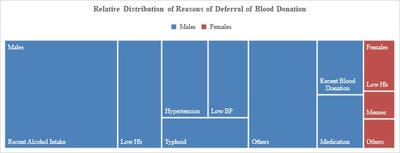Assessment of blood donor selection and deferral pattern in a tertiary care hospital in Central India
Kujur P.1, Kumar Tiwari A.2*, Bagde S.3, Bombeshwar V.4, Ranjan Behera T.5
DOI: https://doi.org/10.17511/jopm.2020.i01.13
1 Pratima Kujur, Professor, Department of Pathology, Government Medical College, Rajnandgaon, Chattisgarh, India.
2* Amit Kumar Tiwari, Assistant Professor, Department of Pathology, Government Medical College, Rajnandgaon, Chattisgarh, India.
3 Sadhna Bagde, Associate Professor, Department of Pathology, Government Medical College, Rajnandgaon, Chattisgarh, India.
4 Vikash Bombeshwar, Demonstrator, Department of Pathology, Government Medical College, Rajnandgaon, Chattisgarh, India.
5 Tapas Ranjan Behera, Resident, Department of Hematology and Medical Oncoloy, Cleveland Clinic, , Ohio, United States of America.
Introduction:Safety and efficacy of blood donations depends on selection of suitable donors. Understanding the prevalent reasons of non-suitability of donors can help understanding the donor pool demographics to develop better donor recruitment and screening strategies. Material and Methods: This is across sectional retrospective study conducted in a tertiary care hospital in central India over a period of two years from January 2017 to December 2018. The donor registry from in hospital donation as well as the blood donation camps were analyzed for the pattern of deferral.Results: Total 18,025 people donated blood during the study period. During this period the number of deferrals was 681. The overall deferral rate was 3.77%.Males constituted the majority of donors (17586, 97.56%), and expectedly majority of deferrals were in males (626, 3.47%). The most common reason of temporary deferral in donors was recent alcohol intake is 197(28.93%) potential donors which was exclusively in the males. The most common reason of permanent deferral was hypertension (59, 8.66%). The common reason for deferral among deferred females was low hemoglobin (26, 47.27%) and that in deferred males was alcohol intake (197, 31.46%). Conclusion: Donor deferral is essential to ensure the safety of both the donor and recipient of the blood; however, it can also lead to non-return of temporarily deferred donors. A pattern and trend in donor deferral could be used as a reference for developing policy and future initiatives in donor education, encouragement and retention.
Keywords: Blood transfusion, Deferral, Donor selection
| Corresponding Author | How to Cite this Article | To Browse |
|---|---|---|
| , Assistant Professor, Department of Pathology, Government Medical College, Rajnandgaon, Chattisgarh, India. Email: |
Kujur P, Tiwari AK, Bagde S, Bombeshwar V, Behera TR. Assessment of blood donor selection and deferral pattern in a tertiary care hospital in Central India. Trop J Pathol Microbiol. 2020;6(1):83-88. Available From https://pathology.medresearch.in/index.php/jopm/article/view/390 |


 ©
© 